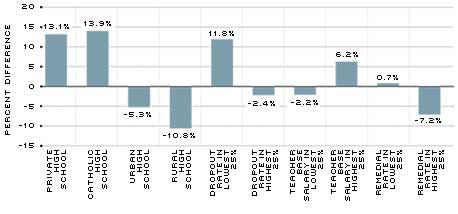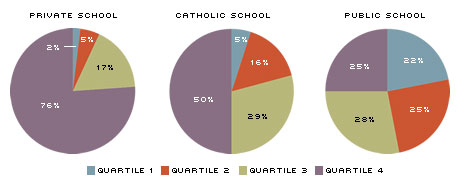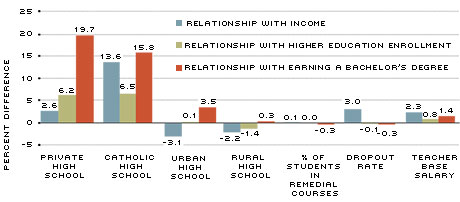Measuring the Effect of School Choice on Economic Outcomes
When measuring the returns to education, economists tend to focus on attainment, typically using the number of years of schooling. Most people, however, would concede that the quality of the schooling also matters. In this article, we focus on the labor market outcomes associated with characteristics of different types of high schools and consider whether school type indicates school quality. In particular, we examine whether students attending different types of high schools—for example, suburban or urban public, religious or nondenominational private—have systematically different economic outcomes.
What Defines School Quality?
Economists define school quality in three ways: resource-based, environment-based and match-based. The resource-based view proposes that school quality can be measured by tangible resources, such as student-teacher ratios, term length and teacher salaries. In a 1992 study of the return to education for men born between 1920 and 1949, economists David Card and Alan Krueger found that those educated in public schools with more teachers per student, longer average term lengths, higher teacher salaries, better-educated teachers and more female teachers earn higher economic returns to schooling. A separate 1996 study, by economists Joseph Altonji and Thomas Dunn, also supports these findings: Higher salaries for teachers and expenditures per student increase their students' wages by 10.6 percent and by 5.6 percent, respectively, upon graduation. However, these wage effects decline with additional years of schooling, implying that high school quality matters just for those who only earn a high school degree. In contrast, other studies, such as economist Julian Betts' 1995 study of white males in the National Longitudinal Survey of Youth, show that traditional measures of school quality—class size, expenditures, teachers' salaries and teachers' level of education—are not significantly related to earnings.
Although these measurable qualities may matter, others argue that a school's environment contributes to students' academic and economic outcomes more than its resources. This view supports the notion that higher-performing schools have students and teachers who are more motivated. This type of achievement-oriented environment is thought to foster both higher expectations and better performance.1 A 2011 study of New York City charter schools by economists Will Dobbie and Roland Fryer found that traditional measures of school quality—such as class size, expenditures per student, and teachers with certifications and advanced degrees—are not correlated with school effectiveness. However, teacher feedback, data-driven instruction, increased instructional time and extreme focus on academic achievement explain almost half of the variation in school effectiveness.
A third measure of school quality is the fit between the school and the student. "Match quality" is a more subjective measure that takes into account how well students' needs and learning styles fit with the culture of their school. The more choices that students and their families have for a high school, the better the match of the school for a particular student. Based on this theory, then, attending the "best" school may not necessarily result in the best outcome for a particular student.
Can School Type Be a Proxy for School Quality?
In a 1992 analysis of data from the High School and Beyond survey,2 political scientist John Witte found that students who attend private and parochial schools are more likely to take advanced courses, to take more academic courses, to have higher expectations of achievement, to have more homework, to face higher levels of discipline, to experience less school violence, to experience more school spirit and to be more involved in school activities. Essentially, the elements that define a productive school atmosphere may be more likely to be present at these schools.
Studies like Witte's suggest that school type may be an effective proxy for school quality, implying that there is some long-run benefit to paying for private school. We use data from the National Education Longitudinal Study (NELS) to examine the relationships among high school characteristics, school type and wages.3 This data set tracks a nationally representative group of students who started high school in 1988 through their mid-20s. In addition to surveying the students, the NELS surveyed each participant's parents, high school teachers and high school administrators. As such, the survey provides information on each student's academic life, social life/behavior, school environment, family environment and achievement.4 Using this information, we look at the relationships between earnings eight years after graduation5 and school type, school geography, school dropout rate, percentage of students in remedial courses and teacher base salary.
How Do Individuals in the NELS Do?
One way to assess the differences in the economic outcomes of individuals in our sample is with descriptive statistics. Figure 1 shows how the relative incomes of individuals vary depending on the traits of their schools. The height of each bar represents the percent difference in average earnings between students who attended schools with various characteristics. The first two bars compare the average income of individuals who attended private or Catholic schools with the incomes of those attending public schools. The next two bars compare all the urban and rural students with all the suburban students. The final six bars compare schools with different quantitative measures of school quality (dropout rate, teacher base salary and percentage of students in remedial courses); the bars compare the average earnings of students who attended schools in either the lowest or highest 25 percent of each measure with the average earnings of students in the middle 50 percent of the study.
Figure 1
Relative Income Based on School Characteristics

SOURCE: National Education Longitudinal Study.
NOTES: The height of each bar represents the percent difference in average earnings approximately eight years after high school graduation between students who attended schools with various characteristics. For example, eight years after graduation, those who attended private high schools earned 13.1 percent more than those who attended public high schools. The sample used in our analysis is restricted to NELS participants who graduated from high school and have a job. School traits can be compared only with those in the same category.
The graph shows that students who attended private and Catholic schools earned 13.1 percent and 13.9 percent more, respectively, than those who attended public schools. Students who attended urban schools earned 5.3 percent less than those who attended suburban schools, while those who attended rural schools earned 10.8 percent less than those who attended suburban schools. When looking at school-level factors, we found that students from schools with the lowest dropout rates and the lowest percentage of students in remedial courses earned 11.8 and 0.7 percent more, respectively, than those attending schools with average rates; students at schools with the lowest teacher base salaries earned 2.2 percent less than those at schools with average teacher salaries. Overall, one can extrapolate from the figure that individuals who attended suburban Catholic high schools with few dropouts, few students in remedial courses and higher teacher base salaries had the highest earnings. These findings support both the resource- and environment-based theories of school quality.
Unfortunately, this descriptive analysis may not conclusively determine whether these school factors matter for three reasons. First, these statistics do not control for additional factors—for example, individual-level characteristics, industry, occupation and educational attainment—that could influence wages. Because wages vary systematically with these factors, simply attending a certain type of school does
not guarantee a significant difference in earnings.
Second, the survey demographics may not paint an accurate picture of actual U.S. demographics. For example, the survey contains a disproportionate number of college graduates. According to the 2000 census, individuals with at least a bachelor's degree represented 25 percent of the population; within the NELS, 45 percent of respondents had at least a bachelor's degree. Since approximately 97 percent of the Catholic and private school graduates enrolled in some form of higher education (versus approximately 82 percent of public school graduates),6 the estimates of average earnings could reflect wage premiums due to higher education rather than to quality of the high school. Thus, simple statistics may not apply to the entire population.
Third, the descriptive analysis does not account for factors that may influence or relate to differences between students at different types of schools. For example, individuals from high-income families may be less likely to attend inner-city public schools, while individuals from lower-income families may be less likely to attend expensive college preparatory schools.
Figure 2 compares the socioeconomic composition of students in our sample for each type of school. The figure shows that socioeconomic status varies dramatically across school types. For example, 25 percent of students who attended public schools were raised in families in the top socioeconomic quartile (quartile 4). On the other hand, 50 percent of those who attended Catholic schools and 76 percent of those who attended private schools were raised in families with the highest levels of socioeconomic status.
Figure 2
Socioeconomic Status and School Type

SOURCE: National Education Longitudinal Study.
NOTES: Each chart compares the socioeconomic composition of students at each type of school. Quartiles are in ascending order (i.e., quartile 4 represents those with the highest socioeconomic status). The sample used in our analysis is restricted to NELS participants who graduated from high school and have a job. The socioeconomic quartiles were calculated by the National Center for Education Statistics for all NELS respondents; its methodology takes into account both family income and family background.
Revisiting the Effect of School Type
To address the issues that arise from looking at simple averages, we attempt to control for differences in student backgrounds—differences such as race, sex and socioeconomic status—as well as industry of employment and occupation. The blue bars in Figure 3 depict the percent difference in earnings between graduates of various types of schools after controlling for other factors that influence wages.
Figure 3
The Relationship between High School Characteristics and Student Outcomes

SOURCE: National Education Longitudinal Study.
NOTES: The bars depict the relationship between earnings and long-term outcomes after controlling for differences in student backgrounds and other factors that would influence wages. For example, private high school graduates earned 2.6 percent more than their public school counterparts, were 6.2 percent more likely to attend college and were 19.7 percent more likely to earn a bachelor's degree. The sample used in our analysis is restricted to NELS participants who graduated from high school and have a job.
According to our estimates, the wage premium associated with attending a private high school is much smaller than the summary statistics in the previous section suggest. After controlling for individual and job characteristics, private high school graduates earn 2.6 percent more than their public school counterparts. This increase, however, is not statistically significant. In contrast, Catholic high school graduates earn a statistically significant 13.6 percent wage premium, comparable to that in Figure 1. This result could indicate that there are significant differences in unquantifiable aspects of school quality that could affect earnings later in life.
Our estimates for school-level factors are also much smaller after controlling for individual-level differences in those surveyed. School geography (urban, rural, etc.), the high dropout rate and the average percentage of students in remedial courses are not significantly related to wages; starting teacher salaries, on the other hand, are related to long-run outcomes.7 Graduates of schools with higher base salaries for teachers experienced a 2.3 percent increase in earnings. Thus, investing in high-quality teachers appears to have an economic return for students regardless of school type. Though the bars for urban and rural schools each show a greater percentage difference in wages, these values are not statistically significant. In other words, they are not statistically different from zero.
Our results suggest that the type of school one attends does not always translate directly to a change in future wages. Does this mean that paying the tuition for a private high school is a waste of money? Economist Wayne Strayer argues that studies should consider estimating the direct (that is, wage) effects and the indirect effects (that is, the chance of graduating from high school, enrolling in higher education or completing a bachelor's degree) to fully understand the effects of school quality. Specifically, he argues that students from higher-quality high schools are more likely to graduate and to attend college. Therefore, it is important to consider the relationship between the high school one attends and the chance of both attending college and of earning a postsecondary degree.
Other studies support Strayer's position that the type of high school one attends is correlated with the likelihood of getting into and attending college. For example, economists William Evans and Robert Schwab compare the effectiveness of public and Catholic schools using individual-level data from the High School and Beyond survey. They found that, after controlling for family background and individual traits, graduates of Catholic high schools are 13 percent more likely to enroll in a four-year college than public school students are.
Using this information, we estimated the relationship among high school type, college enrollment and completion of a four-year college. These results are depicted in the gold and red bars in Figure 3, respectively. The results indicate that graduates of private and Catholic high schools are 6.2 percent and 6.5 percent more likely, respectively, to enroll in higher education than are graduates of public high schools. Further, the students who attend private and Catholic schools are 19.7 percent and 15.8 percent more likely, respectively, than graduates of public schools to earn a bachelor's degree. Since individuals with at least a bachelor's degree in our data set earn approximately 35 percent more than those with only a high school diploma, one can argue that attending a parochial or private school increases the chances of a student getting the college wage premium in the future.
At the same time, students who attend high schools with higher teacher base salaries are 0.8 percent more likely to enroll in college and 1.4 percent more likely to earn a bachelor's degree. Students from schools with higher percentages of students in remedial courses are 0.3 percent less likely to earn a bachelor's degree, but are marginally less likely to enroll in higher education. There is no significant relationship between a school's dropout rate or school location and a student's secondary college enrollment or achievement. Hence, our findings indicate that school type indirectly influences future earnings by creating the opportunity for higher earnings.
Should I Send My Child to an Expensive School?
Although our findings suggest that attending parochial and private high schools may have long-run economic benefits, it is important to keep in mind that students who attend Catholic and private schools come from a nonrandom sample. Students at these schools may have traits that contribute to their academic and economic achievement. Economists call this "selection bias," and its presence can negate causality in a relationship. Thus, the observed correlation between school type and economic outcomes may arise because students who attend private schools are inherently more likely to succeed regardless of where they are educated.
As a result, the returns to the type of high school a student attends may be a better indicator of a student's ability or family finances rather than the school's effect.8 This issue provides evidence for the match-quality measure of school type, assuming individuals who choose the school in which they enroll are selecting the school based on unquantifiable aspects of fit, such as values. As a parent, what matters may be simply focusing on a child's education regardless of the school a child attends.
Endnotes
- See Hanushek, Kain, Markman and Rivkin. [back to text]
- The High School and Beyond survey is a National Center for Education Statistics survey tracking the 1980 senior and sophomore classes through 1992. More information can be found at http://nces.ed.gov/surveys/hsb [back to text]
- See http://nces.ed.gov/surveys/nels88/ [back to text]
- Unfortunately, these data may limit our ability to apply these results to the current, technology-driven economic climate. Additionally, the cohort is not old enough to identify more long-run effects. [back to text]
- This assumes that the members of the survey finished high school within four years (that is, in 1992). For those who were held back, the income figure would simply represent their income in the year 2000. [back to text]
- Also, only 40 percent of public school graduates have a degree from a four-year college, while 80 percent of private school graduates and 67 percent of Catholic school graduates have a degree from a four-year college. [back to text]
- Teacher base salaries are measured using an ordinal variable. Further tests also indicated that urban and rural schools are not statistically different from each other. [back to text]
- See Figlio and Stone. [back to text]
References
Altonji, Joseph G.; and Dunn, Thomas A. "Using Siblings To Estimate the Effect of School Quality on Wages." The Review of Economics and Statistics, 1996, Vol. 78, No. 4, pp. 665-71.
Betts, Julian R. "Does School Quality Matter? Evidence from the National Longitudinal Survey of Youth." The Review of Economics and Statistics, 1995, Vol. 77, No. 2, pp. 231-50.
Card, David; and Krueger, Alan. "Does School Quality Matter? Returns to Education and the Characteristics of Public Schools in the United States." The Journal of Political Economy, 1992, Vol. 100, No. 1, pp. 1-40.
Dobbie, Will; and Fryer, Roland G. Jr. "Getting Beneath the Veil of Effective Schools: Evidence from New York City." Working Paper No. 17632, National Bureau of Economic Research, 2011.
Evans, William N.; and Schwab, Robert M. "Finishing High School and Starting College: Do Catholic Schools Make a Difference?" The Quarterly Journal of Economics, 1995, Vol. 110, No. 4, pp. 941-74.
Figlio, David N.; and Stone, Joe A. "School Choice and Student Performance: Are Private Schools Really Better?" Institute for Research on Poverty Discussion Papers No. 1141-97, University of Wisconsin Institute for Research on Poverty, 1997.
Hanushek, Eric A.; Kain, John F.; Markman, Jacob M.; and Rivkin, Steven G. "Does Peer Ability Affect Student Achievement?" Journal of Applied Econometrics, 2003, Vol. 18, No. 5, pp. 527-44.
Strayer, Wayne. "The Returns to School Quality: College Choice and Earnings." Journal of Labor Economics, 2002, Vol. 20, No. 3, pp. 475-503.
Witte, John. "Private School versus Public School Achievement: Are There Findings That Should Affect the Educational Choice Debate?" Economics of Education Review, 1992, Vol. 11, No. 4, pp. 371-94.
Views expressed in Regional Economist are not necessarily those of the St. Louis Fed or Federal Reserve System.
For the latest insights from our economists and other St. Louis Fed experts, visit On the Economy and subscribe.
Email Us


